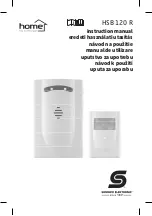
65-0156—1
4
C7024E,F
INSTALLATION
Proper flame detector installation is the basis of a safe
and reliable flame safeguard installation. Refer to the
burner manufacturer instructions and to those included
here. Carefully follow instructions to make the best
possible flame detection application.
BASIC REQUIREMENTS
The combustion flames of most carbon-based fuels
emit sufficient ultraviolet radiation to enable the C7024
Solid State Purple Peeper Ultraviolet Flame Detector to
prove flame presence in a combustion chamber. The
detector is mounted outside the combustion chamber. Its
mounting flange or union is threaded to one end of a
sight pipe inserted through the wall of the combustion
chamber. The ultraviolet sensing tube in the flame detec-
tor sights the flame through the pipe.
When a flame is present, the UV tube in the C7024
senses the ultraviolet radiation emitted. The C7024 pro-
duces a signal that is sent to the amplifier in the flame
safeguard control. The amplified signal pulls in the
flame relay in the control to allow proper operation of
the system.
Because it is necessary for the UV sensing tube to
actually see the flame, it is best to locate the detector as
close to the flame as physical arrangement, temperature,
and other restrictions permit. These restrictions are de-
scribed in detail in the following paragraphs.
DETERMINE THE LOCATION
Before beginning the actual installation, determine
the best location for mounting the detector. Carefully
consider the factors discussed in this section before
deciding on the location.
TEMPERATURE
Install the C7024 where the ambient temperature
(outside the case) will stay within the ambient operating
temperature ratings.
To keep the C7024 below its maximum rating, it
may be necessary to add additional insulation between
the wall of the combustion chamber and the flame detec-
tor. A shield or screen can be added to reflect radiated
heat away from the detector. If the detector continues to
get too hot, cooling is necessary. Refer to the Sight Pipe
Ventilation section. Part number 190105 Water Jacket
is also available for cooling the C7024E Flame Detector.
VIBRATION
If the C7024 is subject to excessive vibration, a spe-
cial antivibration mount, part number 123539, can be
used for the C7024E. If you use this mount, install it
before positioning and sighting the detector.
CLEARANCE
Make sure there is enough room to easily mount the
sight pipe, detector, and all the required fittings, and to
remove the detector for troubleshooting and service.
RADIATION SOURCES (Other than flame)
Examples of radiation sources (other than flame) that
could actuate the detection system:
Ultraviolet sources:
Hot refractory above 2300
°
F [1260
°
C].
Spark:
• Ignition transformers.
• Welding arcs.
• Lightning.
Welding flames.
Bright incandescent or fluorescent artificial light.
Solar radiation.
Gas lasers.
Sun lamps.
Germicidal lamps.
Bright flashlight held close to the sensing tube.
Gamma ray and X-ray sources:
Diffraction analyzers.
Electron microscopes.
Radiographic X-ray machines.
High voltage vacuum switches.
High voltage condensers.
High voltage coronas.
Radioisotopes.
Except under unusual circumstances, none of these
sources (except hot refractory and ignition spark) would
be present in or near the combustion chamber.
The detector may respond to hot refractory above
2300
°
F [1260
°
C] if the refractory surface represents a
significant percentage of the detector field of view. If the
temperature of the hot refractory causes the flame relay
(in the flame safeguard control) to pull in, re-aim the
sight pipe so the detector views a cooler area of the
refractory.
Ignition spark is an intense source of ultraviolet ra-
diation. When installing the detector, make sure it does
not respond to ignition spark.
SINGLE BURNER REQUIREMENTS
The detector must have an unobstructed view of a
steady part of the flame it is supervising. This requires a
proper sighting angle and minimized ultraviolet radia-
tion attenuation effects. When supervising only one
burner, sighting requirements are simplified.
SIGHTING ANGLE (See Fig. 3)
The first 30 percent of a flame nearest the burner
nozzle (flame root) emits the most ultraviolet energy.
Also, if the detector sights the flame at an angle instead
of perpendicularly, it views more flame depth. There-
fore, the best sighting angle is nearly parallel to the axis
of the flame, permitting the detector to view a large
portion of the first 30 percent of the flame nearest to the
burner nozzle, as illustrated in Fig. 3.
Summary of Contents for C7024E
Page 14: ...65 0156 1 14 ...
Page 15: ...15 65 0156 1 ...


































